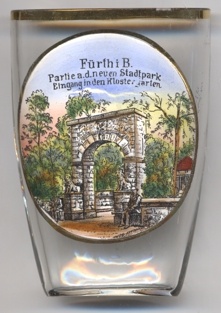

|
| DEUTSCHLAND | GERMANY |
| Bundesland: Freistaat Bayern | Bavaria |
| Regierungsbezirk: Mittelfranken | |
| Stadt: Fürth |
Fürth is situated at an elevation of 294 m at the confluence of the rivers Rednitz and Pegnitz, which join here to form the Regnitz. Fürth is contiguous with the larger city of Nuremberg, the centres of the two cities being only 7 km apart. Fürth, Nuremberg and Erlangen, together with some smaller towns, form the "Middle Franconian Conurbation", which is one of 23 "major centres" in Bavaria and one of the 11 German metropolitan regions. The municipality has a population of about 118,400 (2012).
The first mention of the settlement of Fürth, which had probably already existed for some time, was in a document dated 1 November 1007,
in which Emperor Heinrich II donated his property in Fürth to the newly created Bishopric of Bamberg. The name
Fürth derives from the German word for "ford", as the first settlements originated around a ford. In the following years, Fürth was granted
market privileges, but these were later lost to the neighbouring Nuremberg, under Heinrich III. From 1062 onward, Fürth was again permitted
to have a market, but by that time Nuremberg was already the more important town. In the following centuries, the town was under varying authority,
involving the Bishopric of Bamberg, the Principality of Brandenburg-Ansbach and the City of Nuremberg. For a long time, the character
of the settlement remained largely agricultural, and in 1600 the population was probably still only between 1000 and 2000. In the Thirty Years' War,
Fürth was almost completely destroyed by fire. In 1835, the first German railway was opened between Nuremberg and Fürth. Throughout the Cold War,
Fürth had a significant NATO presence, especially the U.S. Army, due to its proximity to both the East German and Czech borders.
[https://de.wikipedia.org/wiki/Fürth, http://en.wikipedia.org/wiki/Fürth]


The  Stadttheater Fürth (Municipal Theatre) [left] was built in 1901–2902 by
by Ferdinand Fellner and Hermann Helmer for the city of Fürth, using plans they had originally designed for the
Municipal Theatre of Černivci (Ukraine) in 1900. The Černivci project had been put on hold at the time. When it was finally constructed in
1904–1905, the original designs were used with slight alterations. Hence, the theatres at Černivci and Fürth are very similar in appearance.
The theatre was opened on 17 September 1902 with Beethoven's "Fidelio". Originally it was used in co-operation with the Nürnberg theatre company.
Between 1933 and 1944 it was used by a resident theatre company, notably for operetta performances. After World War II, the U.S. Army used it
as a military cinema. From 1952 it was again used as a theatre in co-operation with the Nürnberg theatre company. Alterations of the stagehouse and
stage technology and interior renovations were made in 1971/1972. The original capacity was 1000 seats, today the theatres has 707 seats.
Stadttheater Fürth (Municipal Theatre) [left] was built in 1901–2902 by
by Ferdinand Fellner and Hermann Helmer for the city of Fürth, using plans they had originally designed for the
Municipal Theatre of Černivci (Ukraine) in 1900. The Černivci project had been put on hold at the time. When it was finally constructed in
1904–1905, the original designs were used with slight alterations. Hence, the theatres at Černivci and Fürth are very similar in appearance.
The theatre was opened on 17 September 1902 with Beethoven's "Fidelio". Originally it was used in co-operation with the Nürnberg theatre company.
Between 1933 and 1944 it was used by a resident theatre company, notably for operetta performances. After World War II, the U.S. Army used it
as a military cinema. From 1952 it was again used as a theatre in co-operation with the Nürnberg theatre company. Alterations of the stagehouse and
stage technology and interior renovations were made in 1971/1972. The original capacity was 1000 seats, today the theatres has 707 seats.
[http://www.andreas-praefcke.de/carthalia/]
(See also list of further buildings by Fellner and Helmer that are depicted on glasses of this collection.)

Glass no. 4893 [left] is labeled Fürth i[n] B[ayern] / Partie a[n] d[em] neuen Stadtpark / Eingang in
den Klostergarten ('Section at the new Municipal Park / Entrance to the Monastery Garden').
The first lot of the  Stadtpark
Stadtpark
[https://www.fuerthwiki.de/wiki/index.php/Stadtpark]
Another glass in this collection is a souvenir from Furth bei Göttweig in Lower Austria.
![[scale]](lineal.jpg)